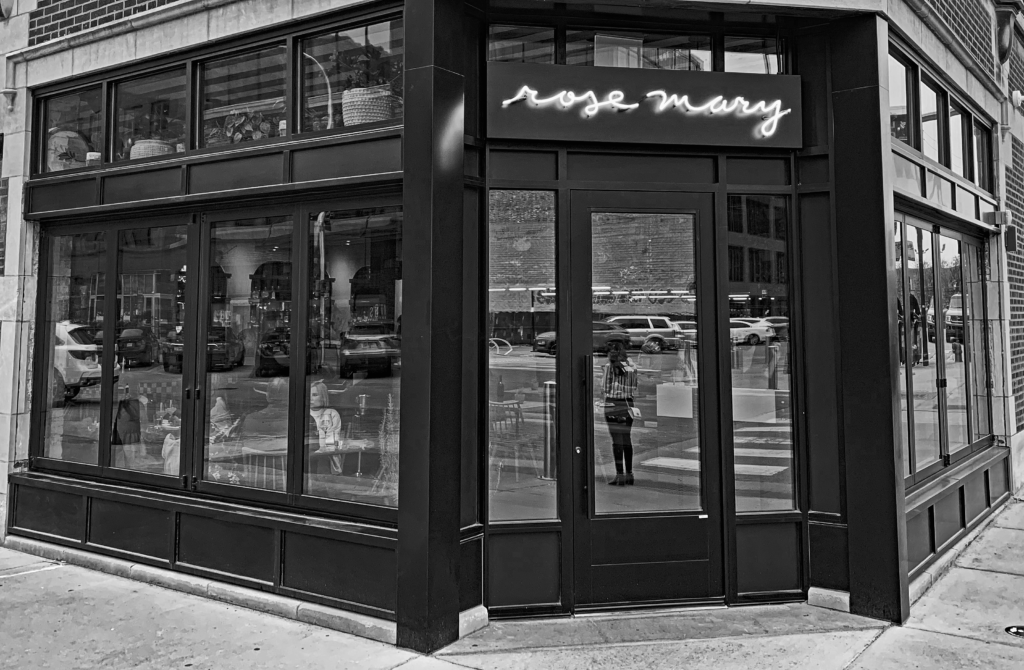Chicago is utterly obsessed with Rose Mary at the moment. No, not the herb—the “dew of the sea” as it’s called—but the newly-opened Fulton Market restaurant from Top Chef winner Joe Flamm.
The establishment takes its name from the chef’s grandmothers—Mary and Mary Rose—with a wink towards that aforementioned, herbaceous homonym. For Rose Mary serves Flamm’s distinct fusion of Italian and Croatian culinary traditions, and rosemary—the herb—grows along the Mediterranean coastline both countries share.
Now, you pay little mind to pretentious cooking competition shows such as Top Chef. While the media property has done well to congregate some of the country’s best talent during the fifteen years since its debut, modern foodies are faced with diminishing returns should they outsource their taste to Tom, Padma, Bravo, and their assorted promotional partners.
Just think: when Top Chef debuted in the spring of 2006, New York City had not yet received its first edition of the Michelin Guide! Yes, the Big Apple’s inaugural stars would come later the same year, but San Francisco’s would not arrive until 2007 and Chicago’s not until 2011. Back then, netizens still discussed cuisine within the hallowed halls of online message boards—a far cry from our contemporary foodie influencer hellscape.
While the Top Chef of yore cultivated a new generation of consumers who could appreciate (and would pay for) Michelin-rated cuisine, the show now exists more as a launchpad for locally-respected chefs looking to attain a national reputation. To some degree, this reflects American food culture’s coming of age: citizens of all stripes have largely been sold on “food as art,” so attention can now be lavished on the personalities who put the plates together.
Today, there’s a flavor of celebrity chef suited to every palate—and you can trust that one’s self-branding and personal story is being judged just as much as the dishes served on any cooking competition show. It’s only in our nature after all. Humans enjoy that glass of wine just a little bit more when they perceive a famous label—or, in fact, just some fancy (but utterly irrelevant) packaging.
Why wouldn’t we enjoy the food of that enchanting, sociable chef more than the quiet artisan? At the very least, once a certain level of technical mastery is achieved, what other than someone’s likability could possibly make the difference when splitting hairs between two otherwise excellent dishes? Yes, there are individual nostalgias to contend with, webs of food memories that are uniquely our own. But these internal processes are mediated by external concerns, and do Top Chef’s judges seem like the sort to resist a marketing masterstroke when it presents itself? Tom Colicchio surely hasn’t run a decent restaurant in the better part of a decade!
But Flamm’s success—within Chicago at least—stands distinctly on its own, apart from the machinations of the food media complex. The chef grew up making pasta with his grandmother (Mary), graduated from the Windy City’s former Le Cordon Bleu location, then worked under Art Smith (Table 52), Stephanie Izard (Girl & the Goat), Bill Kim (Belly Q), and Tony Mantuano (Spiaggia).
Though Smith, Izard, and Mantuano are certainly no strangers when it comes to television appearances—you might even label them early masters of the “celebrity chef” moniker—Girl & the Goat and Spiaggia both rank as two of Chicago’s finest restaurants. And while the establishments possess distinct styles (contemporary American vs. coastal Italian) and offer distinct levels of service (buzzing, homey tavern vs. Michelin-starred haven with a view), both have long been known for exceptional, inventive food in an eminently welcoming environment.
Few Chicago chefs can tout such a proud lineage and—ignoring Flamm’s larger fame—Rose Mary would have ranked as the year’s biggest opening merely due to the nature of its concept: an affordable, trendy, primely-located Fulton Market tavern that unites the city’s Italian and Eastern European food traditions under one roof. It’s Spiaggia’s legendary pasta meets Girl & the Goat’s dynamism with an additional Croatian element at play that locals have never seen before. It’s a chance for Chicago’s hometown hero to strut his stuff and express a vision all of his own.
It is no wonder, then, that Rose Mary has been booked solid since opening on April 20th. While you have witnessed diners snag some of the ample bar and high-top seating at opening, those looking to reserve a table at prime times (or, really, any time at all) had better be prepared to think two months in advance. Truth be told, you might even need to wake up at midnight to secure seats on a coveted Friday or Saturday night—and few of Chicago’s restaurant could ever command such devotion.
Now, you loath the practice of evaluating restaurants so close to opening. Critics not only must visit an establishment a minimum of three times before passing judgment, but they should—ideally—space those visits out over the course of a couple (or a few) months. The duty to inform consumers as to a restaurant’s quality (before they potentially waste their money there) needs to be measured against respecting a restaurant’s capacity for growth.
Of course, if an establishment is taking people’s money, then criticism—of one sort or another—is fair game. However, given the rarity with which critics update their ratings, hanging a “one star” albatross around a restaurant’s neck—rendering them, more or less, finished while denying them the time to hit their stride—must be approached with care.
Restaurants that serve seasonal tasting menus, for example, might only introduce new dishes every two or three or four months. A critic who visits multiple times close to opening can judge the consistency of the same dishes, can key in on the virtuosity of those same compositions, but will lose out on any sense of how the chef’s vision adapts itself to new ingredients. By the time consumers read the critic’s report, the season likely will have changed and the dishes discussed in writing will have disappeared forever. In this manner, the critic can be said to have judged a singular menu more than they did the entirety of the living, breathing, ever-growing restaurant.
(Indeed, you have visited Curtis Duffy’s Ever more than three times in the year since the establishment opened. While it would be fair to critique the restaurant on the baseline experience offered across all of your dinners, you think a more enlightening discussion of the chef’s abstract cuisine demands tracking the changes made across distinct menus. Such an article will be forthcoming as Ever celebrates its first “birthday”).
Ultimately, influencers and unethical critics are more than happy to lavish praise so that they may justify the cost of their one visit. Meanwhile, they offer no greater insight than an aggregate of individual Yelp reviews does. (In fact, due to the necessary superficiality of such conspicuous consumption, you would wager the Yelp reviewers—in their innocence—are much more truthful).
The true role of the critic is to transcend the individual experience by discovering the foundations and patterns that ensure any reader, at any point in time, can come to an informed decision as to where they’ll best spend their money. In the same manner, tracking a restaurant’s growth pays respect to the chef. It incentivizes—rather than punishes—experimentation while ensuring facets of enduring quality receive their due respect. It is this balance—between rootedness and reinvention—that makes the world’s greatest restaurants so captivating.
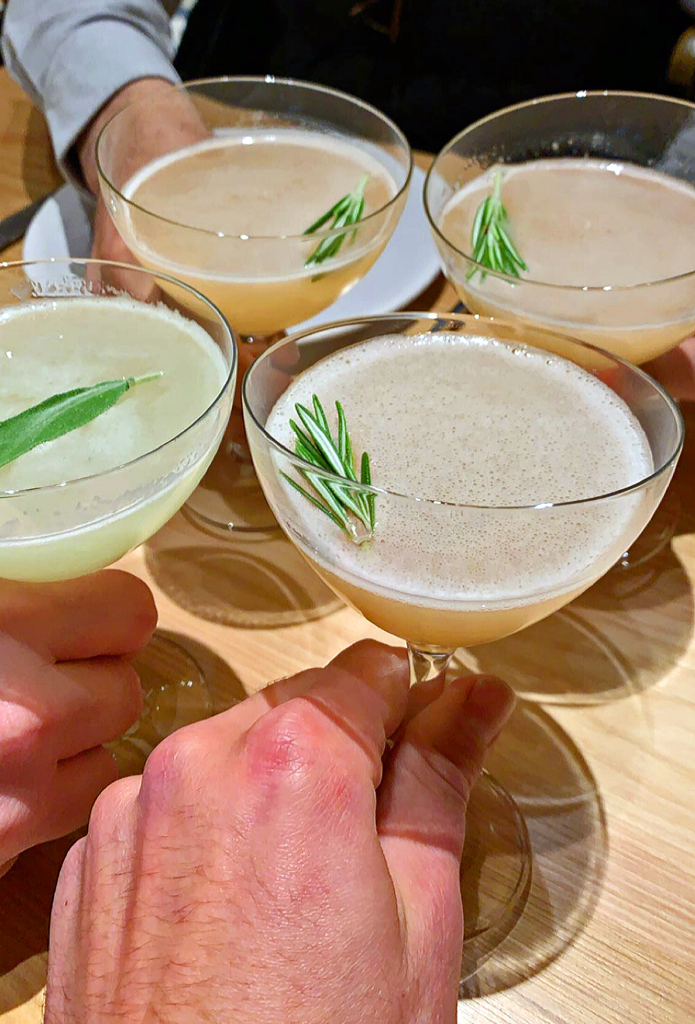
Rose Mary does not serve a tasting menu. It lands firmly in the premium small/large shared plate category—just as Girl & the Goat and fellow Spiaggia alumna Monteverde do. Many of the dishes on Flamm’s menu—you imagine—will form something of core. They will come to stand for the restaurant’s identity, enticing a continual flow of customers. Other dishes will come and go with the season, ensuring guests are spoilt for choice between the tried and true favorites and the more experimental offerings.
At the time of writing, you have visited Rose Mary twice. You have been quite pleased with your experiences; however, you will defer writing any rigorous review of the restaurant until more time has passed. (Surely, nobody is waiting on your word before beating down the doors to dine there). Nonetheless, the full extent of Flamm’s vision can only be revealed in time. And you will wait to see how the chef tinkers with old dishes and embraces new ones before deciding just where the establishment ranks among Chicago’s best.
In the meantime, just for fun, you thought you would put Rose Mary’s seven different pasta dishes through the ringer. Given that Flamm is something of a wizard with the form—anyone who has tried Spiaggia’s truffle gnocchi can attest to that—and that his pastas form the most distinct core of the menu at present, you think this ranking can prove instructive in the interim before a full-fledged review.
Such a comparison does not pass judgment on the entirety of the concept but, rather, guides consumers towards informed decision making with regards to the most populous portion of the menu. You have chosen to omit the three risotto dishes that occupy a separate category on the menu, for, while they were all highly pleasing, the textural uniformity of the rice means that customers would do well to simply choose which of the three features the most attractive accompanying ingredients.
All seven pastas were evaluated at least once. The first-, second-, and seventh-placed pastas were each sampled during both of your visits. The pastas were rated by a diverse panel of four diners whose scores were then tabulated. The subsequent ranking, presented in ascending order, is based on those scores with the addition of your tasting notes.
With that “bit” of grounding and methodology settled, let us begin!
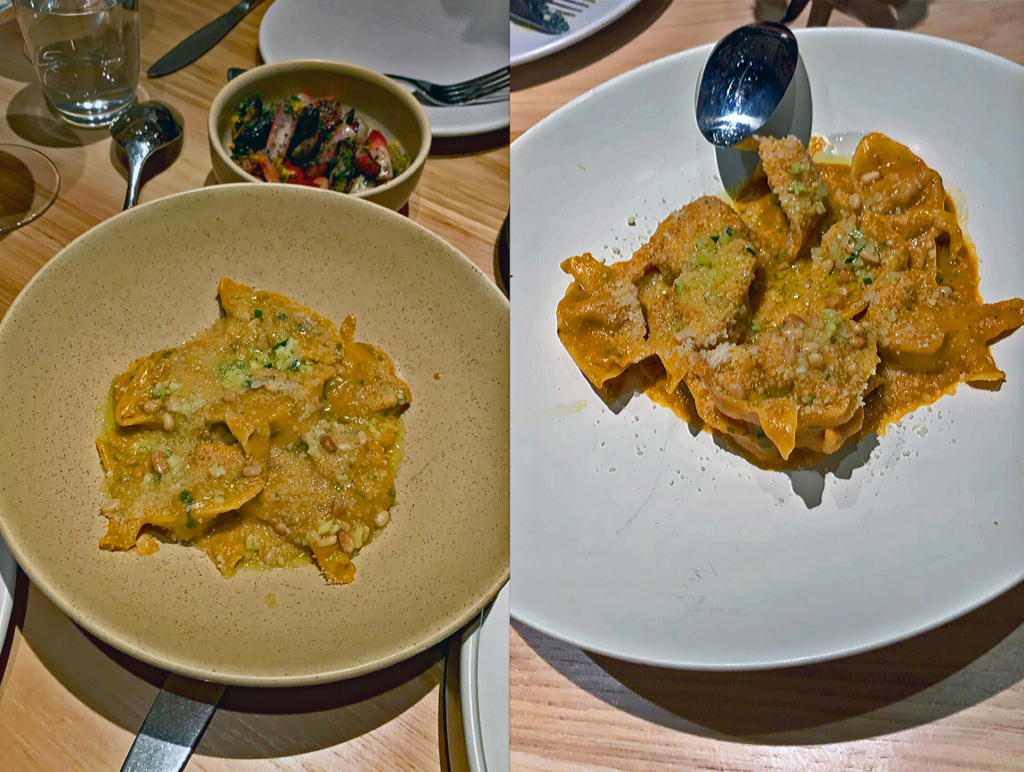
#7. Tortellini Djuvec
Coming in last place, Rose Mary’s tortellini also happens to be one of the restaurant’s vegetarian pastas. While two of the four panelists ranked the dish well below the other six, the remaining two scores placed it firmly in the middle of the pack. Thus, though the tortellini is clearly divisive, the preparation can hardly be labelled “bad.”
The term djuvec—also spelled “güveç”—refers to a kind of earthenware pot used throughout Turkey and the Balkans. The word also encompasses a range of oven-baked vegetable stews (similar to ratatouille) made using the vessel. While these stews can often incorporate meat, traditional vegetarian djuvec do exist and incorporate ingredients such as zucchini, eggplant, peas, and carrots.
Rose Mary’s tortellini djuvec comprises red pepper and eggplant—which add depth of flavor and body to the tomato sauce—and preserved zucchini—which is used to stuff the “little cakes” of pasta (whose shape is also said to be modeled after a woman’s navel). Freshly-grated Parmigiano and pine nuts complete the presentation.
The panelists who disliked the dish termed it—in derogatory fashion—“that pasta with the orange sauce.” You, personally, enjoyed the tortellini but can see how the stewed, sweet and sour notes of the pepper, eggplant, and preserved zucchini might not be to everybody’s taste. Still, the pasta itself displayed a lovely mouthfeel that was enriched all the more due to the consistency of the sauce. The pine nuts, too, provided a key textural contrast that worked against any sensation of heaviness.
You would not label the tortellini djuvec a disappointment by any means, but guests interested in the dish should meditate on how much they enjoy concentrated flavors of eggplant and zucchini. Those notes, you think, provide the key to understanding whether one will find the preparation palatable.
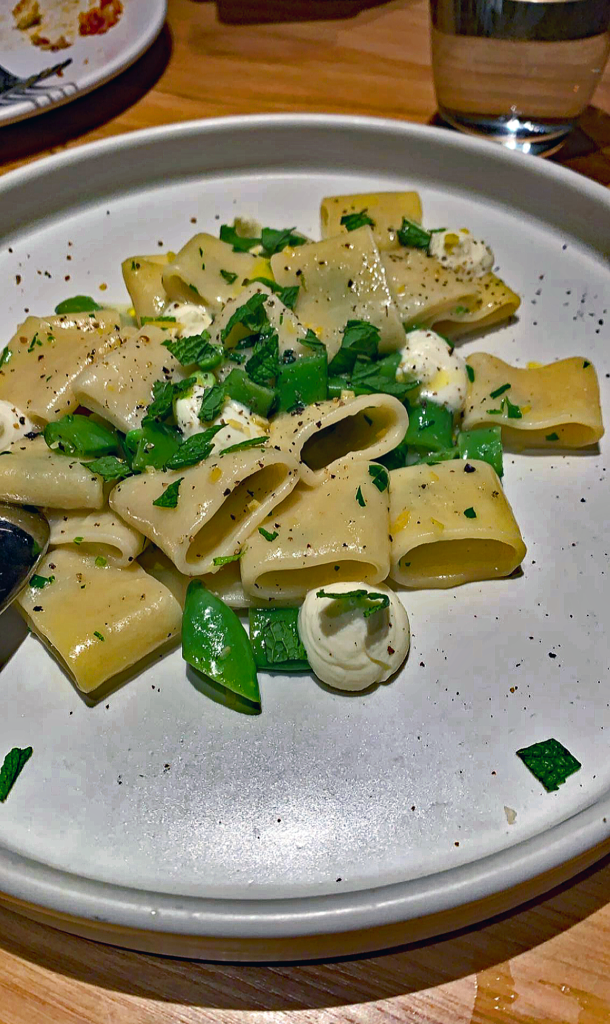
#6. Rigatoni
In sixth place, Rose Mary’s rigatoni ranks as yet another of the restaurant’s vegetarian pastas. (The panelists, you must clarify, are no partisans when it comes to enjoying or abstaining from animal protein. It may simply be the case that most pasta sauces benefit from the added complexity an undercurrent of meaty goodness may add).
While the word “rigatoni” refers to the ridges that line some renditions of the pasta, Flamm’s version takes the form of wide, smooth tubes. They are coated in “buffalo butter” (that is, butter made from the same buffalo milk typically used for traditional Neapolitan mozzarella) and topped with “all of the peas,” dollops of ricotta cheese, and mint.
This pasta proved less divisive than the tortellini, with all four panelists awarding it average scores. The rigatoni, again, possessed a lovely mouthfeel—the lack of ridges lending the dish something of a “buttered noodle” character. At the same time, the pasta—only being coated in that buffalo butter—stood as the most lightly flavored of the bunch.
The snap of the peapods, pop of the peas themselves, chew of the noodles, and creaminess of the ricotta deposits made for an engaging textural experience. However, that lack of a bonafide “sauce”—even accounting for the hint of mint present—made for a dish that lacked just a little of the flavor intensity the panel found so impressive elsewhere.
While the tortellini’s djuvec-inspired sauce was polarizing, the rigatoni’s lack thereof was inoffensive. Instead, it ranks as one of the menu’s most delicate compositions—a label that might appeal to some diners.
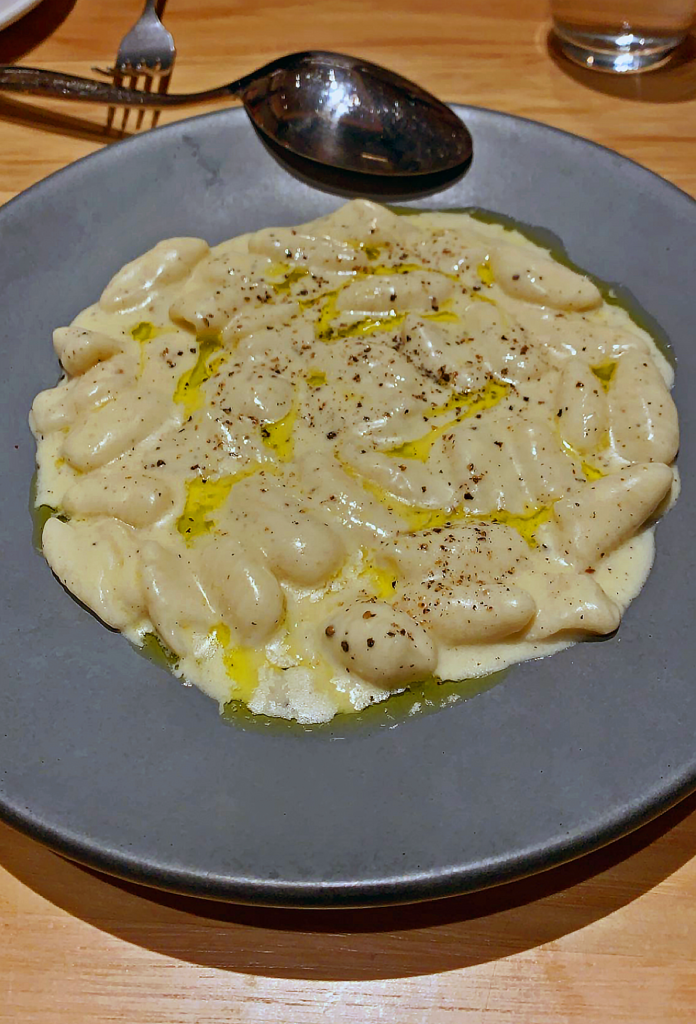
#5. Cavatelli ‘Cacio e Pepe’
The fifth-ranked pasta dish at Rose Mary—yet again—does not feature any meat. However, relative to the tortellini and rigatoni, the cavatelli ranks far closer to the remaining four dishes. (Truth be told, the panelists’ scoring of the “top 5” was so close that guests can hardly go wrong with any of them).
Cavatelli means “little hollows”—a reference to the dimple that marks the underside of each piece of the pasta. Broadly speaking, they are made from semolina flour and shaped into little shells or “hot dog buns” with a ridged pattern. “Cacio e pepe,” of course refers to the famous Roman preparation of noodles in a simple sauce made from pasta water, Pecorino Romano, and ample black pepper. Less strictly speaking, it’s a cheese sauce that begs comparison to Spiaggia’s legendary gnocchi with ricotta sauce or Monteverde’s “cacio whey pepe” (recently replaced by a “pecorino e limone” preparation).
Rose Mary’s rendition of cacio e pepe features a sauce that’s true to form: it is thick enough to coat the pasta with an attractive sheen while avoiding any sense of glueyness. Choosing cavatelli, of course, is a bit of a curve ball. The “little hollows” offer a pleasant chew—and their ridges, indeed, work to capture a hearty coating of the sauce. A hearty drizzle of olive oil adds additional complexity, but you think the black pepper—strangely enough—was mishandled.
As it stands, the pepper is ground a bit to finely to have the desired textural impact. Had it provided a greater sense of crunch, the dish might have ranked higher. For the cavatelli—coated in the cheese sauce and absent that contrasting texture—can come across as amorphous and dense. The pasta misses some of the interplay that a tangle of noodles—as in the classic Roman preparation—can provide.
Nonetheless, the dish delivers a delectable cheese sauce that the city’s legions of mac and cheese aficionados are sure to love. And the cavatelli itself forms a fitting canvas for that sauce. The preparation only misses a tiny balancing element that would keep you coming back for more despite the richness on offer.
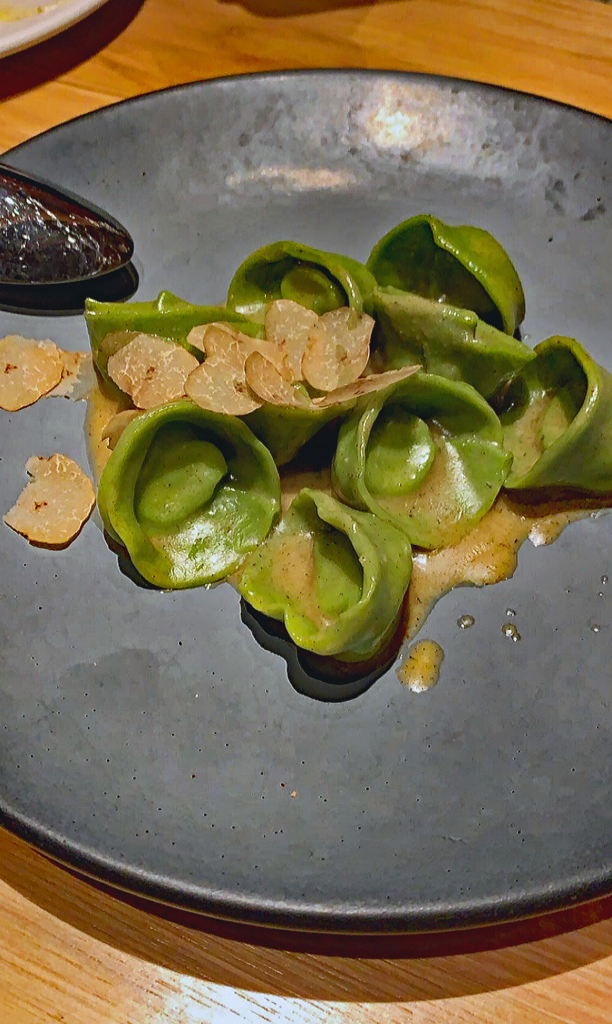
#4. Spinach Cappelletti
In fourth place—at long last—ranks a vegetarian pasta that can really walk the walk among Rose Mary’s meatier offerings. And the presence of truffles in this particular vegetarian pasta—it must be said—is merely a coincidence. That totemic luxury ingredient is always welcome, but, here, it merely forms the cherry on top of a most-elegant composition.
Cappelletti—or “little hats”—are something like an oversized tortellini. Rose Mary’s rendition is a bit rounder and features a deeper “bowl” than the navel-shaped pasta from the djuvec dish. Flamm’s cappelletti features an addition of puréed spinach into its dough, lending the little hats a striking green tone and an undercurrent of sweetness built into each bite.
The pasta is paired with a Parmigiano fonduta—essentially, a Piedmontese fondue—with a far lighter consistency than that seen in the cacio e pepe. In fact, the “King of Cheeses” is rarely melted in such a way, making Flamm’s concoction something of a marvel. (Given Parm’s natural nuttiness—its intensity of umami—you’d be forgiven for thinking the sauce was a brown butter!) The dish is topped with shavings of bianchetti—“little white”—truffles from Tuscany, which impart a sharper, garlicky taste than their costly counterparts from Alba.
In terms of mouthfeel, Rose Mary’s cappelletti is one of the menu’s standouts. The pasta’s wide, deep bowl acts as a reservoir for the viscous fonduta (which possesses greater flavor than the cacio e pepe’s sauce but less “sticking power”). Yet, the cappelletti’s “rim” is thin enough to allow—in the mouth—for a pleasurable convergence of one end onto the other. This makes for a doubly chewy sensation that traps the fonduta and truffle shavings within collapsing layers of the pasta.
The end result is an absolute “umami bomb” moderated by the natural balancing effect of the spinach in the dough. The dish received high scores from all four panelists and could very well have ranked higher if not for the stiff competition offered by the following items.
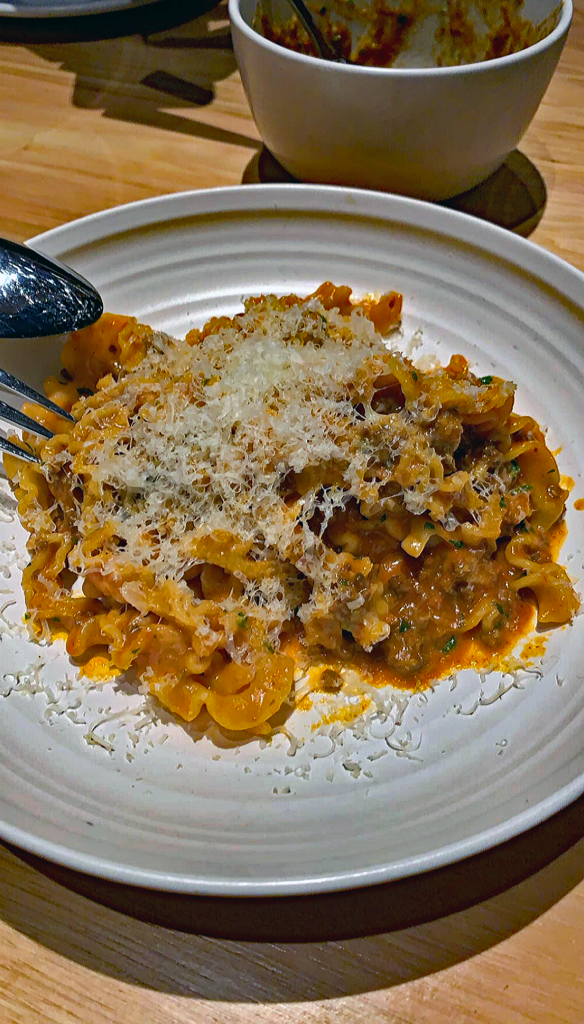
#3. Lamb Ragù Mafaldine Abruzzi
As we enter the top three, it is worth noting—once more—that each of these rarefied dishes were split only by a hair. It can very well be said that each ranks among the best pastas both at Rose Mary and across Chicago at large.
Abruzzo is a mountainous region of Italy located east of Lazio (which contains the capital city Rome). The plural “Abruzzi” refers to an era from 1816 to 1860 when Abruzzo was split into smaller territories—Abruzzo Citeriore and Abruzzo Ulteriore—under the administration of the Kingdom of the Two Sicilies. It is for this reason—despite the region’s geographic location in the center of Italy’s peninsula—that Abruzzo has long been considered part of “Southern Italy.”
The area not only reflects that southern culture, but it is known as “the greenest region in Europe,” having devoted almost half of its territory to national parks and protected nature reserves. For this reason, “forte e gentile” (strong and kind) has become the motto of Abruzzo’s landscape and the “hill people” who call the region home.
Lamb ragù is something of a specialty in Abruzzo, where sheep have been raised for centuries in the many mountain pastures that characterize the landscape. While the Abruzzesi traditionally utilize spaghetti alla chitarra—a square shaped noodle—for their preparation, Flamm has opted for mafaldine. These wide, flat ribbons of pasta with scalloped edges were first created in Naples and named after Mafalda of Savoy (the second daughter of King Victor Emmanuel III). For this reason, mafaldine may also be called “reginette” (or “little queens”).
Rose Mary’s preparation combines the mafaldine and lamb ragù with peppers—chiles being a unique characteristic element of Abruzzese pasta dishes—and caciocavallo—a sharp, spicy cow or sheep’s milk cheese (similar to Provolone) that is made across Southern Italy. In this manner, the pasta’s designation as “Abruzzi” is apt. It comprises not only classic Abruzzese elements like lamb and chile pepper, but Southern Italian elements like the mafaldine noodle and the caciocavallo. The dish, in some sense, tells the story of “Abruzzi” and the lasting influence southern culture has had on Abruzzo.
And, historical intrigue aside, Flamm’s mafaldine tastes delicious. The noodles—a bit wider than usual and divided into strips a few inches long—possess a real sense of heft. They demand a bit more chewing than the other pastas, which negates the need for any additional textural elements on the plate. Instead, the mafaldine’s ridges capture an ample amount of the ragù, peppers, and cheese—ensuring each bite is complete and cohesive. The lamb itself is perfectly tender and robust in flavor (though not at all gamey). It acts as a sponge for the strong flavors of chile and caciocavallo—forming a cohesive and highly savory combination that kept the panelists coming back for more.
The mafaldine deserves special credit for highlighting a piece of Italy’s cultural history. All the more, it impresses as the most intensely flavored of all the pastas you sampled. For some guests, this interplay of such bold flavors will offer the highest satisfaction of all the options.
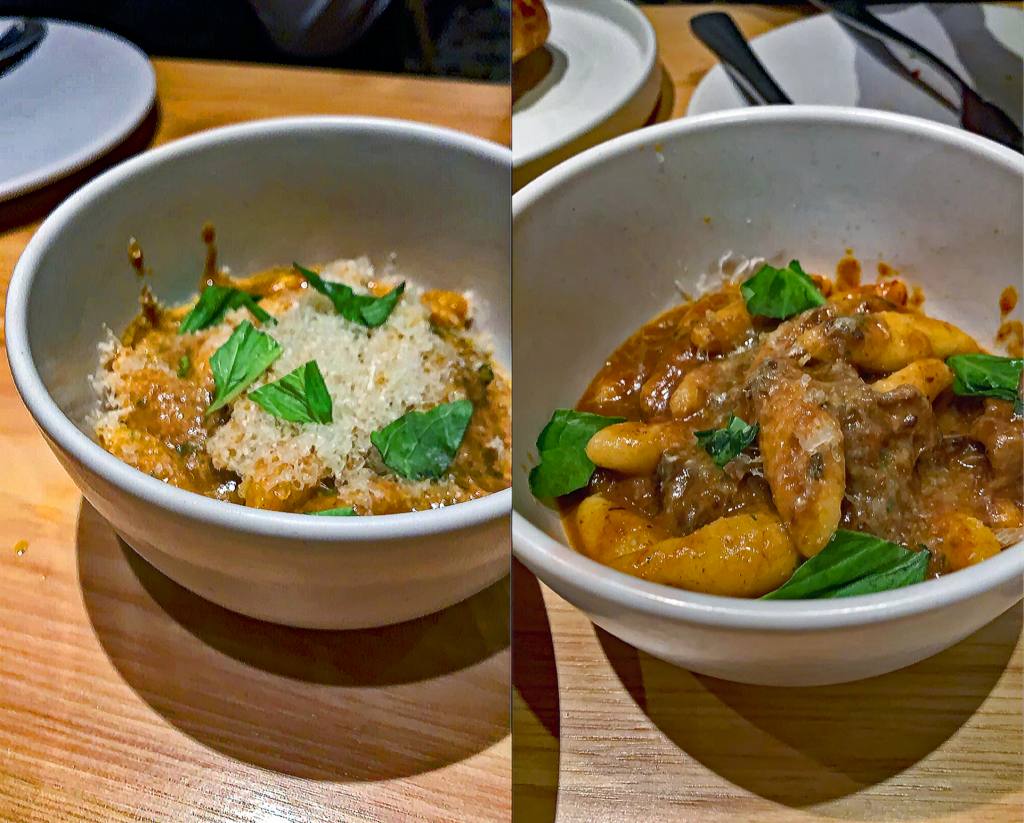
#2. Gnocchi
In second place—having just barely fallen short of taking the crown—is Flamm’s answer to the legendary gnocchi preparation that he once presided over so impressively at Spiaggia. However, Rose Mary’s rendition—other than the presence of that same, pillowy pasta shape—embraces an entirely different combination of flavors.
The principle element is called pašticada, a braised beef dish that finds its origin in Dalmatia. The meat—typically an eye of round—is stuffed with garlic and bacon then marinated in wine vinegar overnight. After being seared, the beef is slowly simmered in sweet wine for several hours before being cut into thick slices and served atop pasta.
Rather than eye of round, Flamm makes use of smaller, more flavorful beef cheeks. These smaller chunks have the added benefit of better incorporating themselves into the pasta (instead of the pasta, in essence, only serving to mop up the pašticada’s drippings). The cheeks cannot exactly be stuffed in the aforementioned manner, but they also demand less of that additional flavoring. Instead, Rose Mary’s preparation retains only the traditional dish’s essential character: an appealing sweet and sour contrast derived from wine vinegar and sweet wine.
The gnocchi—plump, torpedo-shaped dumplings made from potato—and the beef cheek pašticada are topped with basil and Paški sir. The latter ingredient, also known as Pag cheese, comes from the titular Croatian island in the northern Adriatic Sea. There, sheep outnumber humans 5 to 1 and lend their milk to a rich, flavorful cheese with sweet notes of butterscotch and bits of fennel in the rind.
Diving into the dish, you were struck by the absolute unctuousness of the gnocchi. It is undoubtedly of the same standard seen at Spiaggia—which is to say that the texture is impeccable. The pasta forms a soft, creamy canvas for the tender chunks of beef cheek that—nonetheless—maintain a tiny bit of structure so as to lend the plate textural intrigue. The savory flavors drawn from the slow-cooked meat are augmented by the sweet/sour wine sauce elements that blend beautifully into the butterscotch notes of the Pag cheese. The basil—though it seems but a visual flourish—enacts a careful balancing effect against such an onslaught of richness.
The gnocchi arrives at the table in a bowl that seems noticeably smaller than any of Rose Mary’s other pasta preparations. The portion almost seems as if it will not be enough for four people to split. Yet each individual spoonful—containing no more than a single gnocco and a bit of beef cheek—delivers a stunning, self-contained, and utterly complete taste experience.
While the lamb mafaldine wielded its intense flavors with a sense of rusticity, Flamm’s gnocchi can only be labelled an ode to decadence. The ethereal pasta disappears when it touches the palate—only to storm the citadel of satisfaction with layers of simmered beef flavor buttressed by the elements of Croatian wine and cheese that kept you coming back for more.
As much as you’d love to see this gnocchi headline its own truffle pasta dish (à la Spiaggia), you do not see the pašticada leaving the menu (nor should it). For it’s hard to imagine things can get much better, until…
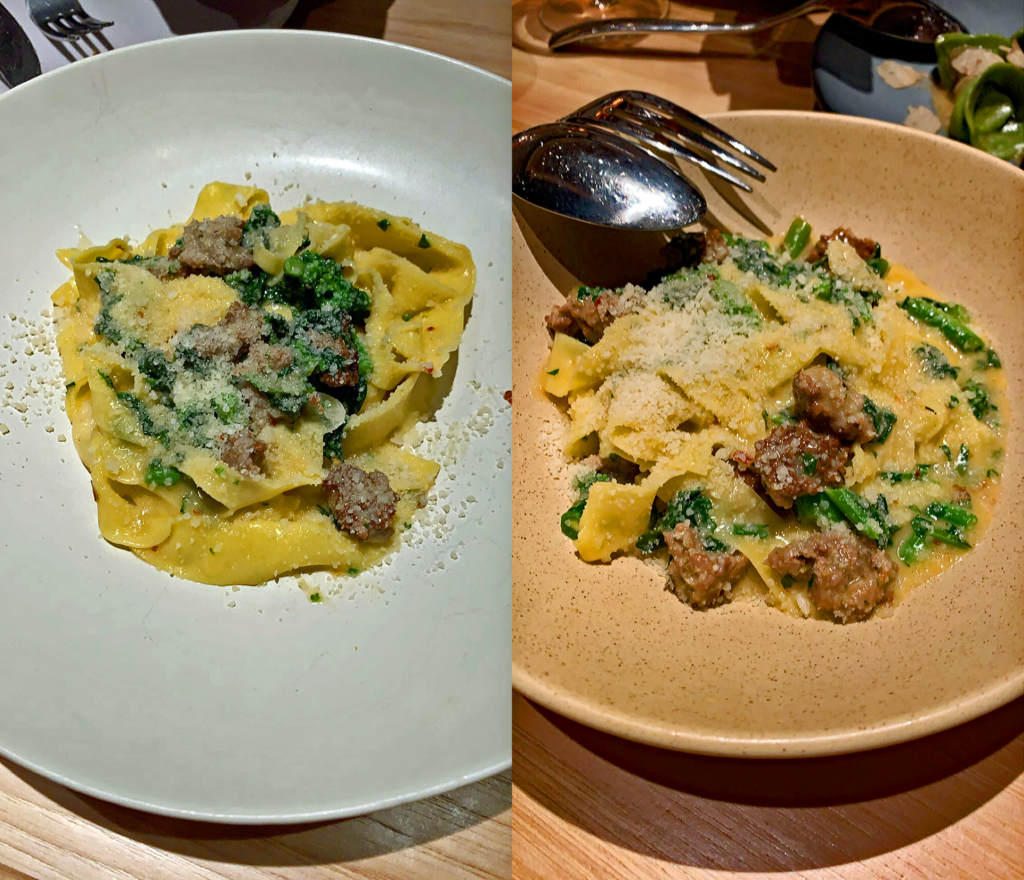
1. Tagliatelle
Taking the top spot is a pasta that reads as being fairly traditional—with only a bit of a twist. Then again, it is something of a truism by now to say that Italian cuisine excels in its simplicity. Interpreted another way, it is fair to say that Italian food is defined by the perfect execution of a few sparing ingredients—and Flamm’s #1 ranked pasta at Rose Mary is a testament to that.
The noodle in question is tagliatelle, whose name is derived from the Italian verb tagliare (“to cut”). Tagliatelle take the form of long, flat ribbons—and it that sense they stand, along with the mafaldine (though slightly less so), as the only “proper” noodle featured in Flamm’s pasta preparations.
The ribbons are nested in the center of a shallow bowl and studded with chunks of duck sausage, slices of rapini, a coating of chili flake, and a healthy grating of Parmigiano. The “sauce,” as far as you know, is nothing more than a bit of the pasta water. It serves to sop up the juices from the meat and vegetable components and congeal it all—along with the cheese and chili—onto the surface of the noodles.
Relative to the rigatoni—which embraced a similar “sauceless” technique—the tagliatelle is a revelation. To start, the noodles achieve a softness of texture—a fleeting feeling on the palate—that eclipses even those excellent gnocchi. They possess just enough structure to make their presence known across a few mouthfilling chews before yielding to their partners in crime. These tagliatelle are the kind of noodles a three Michelin star restaurant would serve with a $200 white truffle supplement. There’s hardly a higher honor for a pasta—and, here, they can impress diners freed from any of that pretension.
The duck sausage, as mentioned early, adds a bit of a twist to the composition. It is leaner than pork—and the chunks are a bit more intense in flavor—but they lend the dish a sharpness that ensures each bite offers adequate meaty pleasure. The duck also forms a perfect foil for the rapini, which adds a marked bitterness and a bit of nuttiness to the pasta along with a lovely crunch from the small segments of stem interspersed among the leaves. The chili flakes, it must be said, form something of a background note. They work to round out the stronger flavors of the duck and rapini. The parm, likewise, joins everything together in perfect harmony—its own nutty, umami notes serving to amp up the pasta’s sense of satisfaction.
You think the tagliatelle succeeds in the manner its lack of sauce provides a showcase for the other elements at play. Uncoated by anything but the cheese and chili flakes, the ribbons really have a chance to dance across the tongue. When the chunks of duck sausage and crunchy bits of rapini make their way to center stage, they, too, sing clearly.
Yet, with chew after chew, the components join more closely together. The textures and flavors achieve an effortless sort of harmony before your eyes—the soloists become a symphony—and it is revealed how only a handful of exceptional ingredients may come together to make magic.
Rose Mary—across your two initial visits—has revealed Flamm to be every bit the magician. His cuisine builds upon the techniques that have endeared him to Chicago, yet the chef makes clear that he has a culinary voice of his own. The team that surrounds him has proven faultless in weaving the kind of experience that keeps guests coming back. You sure will—and a full review will follow—but, for now, feast on the above assortment of superlative pastas.

